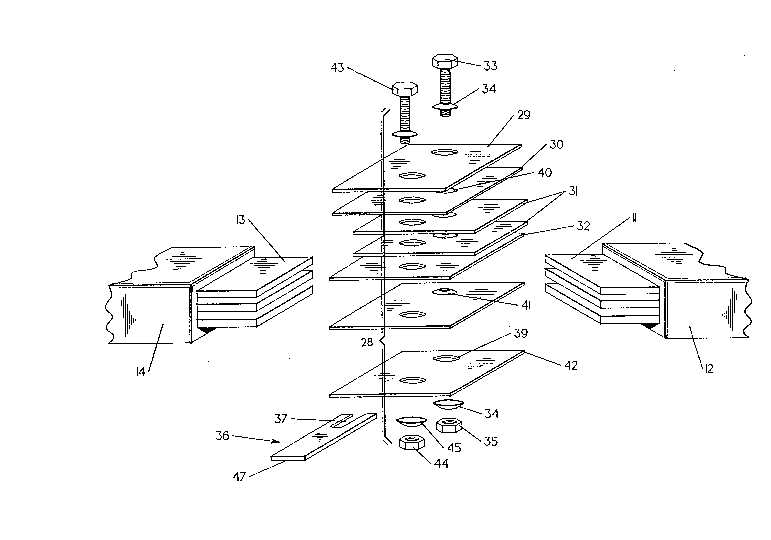Some of the information on this Web page has been provided by external sources. The Government of Canada is not responsible for the accuracy, reliability or currency of the information supplied by external sources. Users wishing to rely upon this information should consult directly with the source of the information. Content provided by external sources is not subject to official languages, privacy and accessibility requirements.
Any discrepancies in the text and image of the Claims and Abstract are due to differing posting times. Text of the Claims and Abstract are posted:
| (12) Patent Application: | (11) CA 2087764 |
|---|---|
| (54) English Title: | ELECTRIC POWER BUSWAY ADJUSTABLE POWER TAKE-OFF-JOINT |
| (54) French Title: | JOINT DE CONTACT REGLABLE POUR BARRE BLINDEE ELECTRIQUE |
| Status: | Deemed Abandoned and Beyond the Period of Reinstatement - Pending Response to Notice of Disregarded Communication |
| (51) International Patent Classification (IPC): |
|
|---|---|
| (72) Inventors : |
|
| (73) Owners : |
|
| (71) Applicants : |
|
| (74) Agent: | CRAIG WILSON AND COMPANY |
| (74) Associate agent: | |
| (45) Issued: | |
| (22) Filed Date: | 1993-01-21 |
| (41) Open to Public Inspection: | 1993-08-11 |
| Availability of licence: | N/A |
| Dedicated to the Public: | N/A |
| (25) Language of filing: | English |
| Patent Cooperation Treaty (PCT): | No |
|---|
| (30) Application Priority Data: | ||||||
|---|---|---|---|---|---|---|
|
41PR-6822
ELECTRIC POWER BUSWAY ADJUSTABLE
POWER TAKE-OFF-JOINT
ABSTRACT OF THE DISCLOSURE
An electric power busway joint includes a plurality of metal
electrically conductive splice plates and electrically
insulative separator plates interleaved to receive the ends of
adjoining electrical busway power conductors. The busway joint
is defined by a pair of apertured side plates which receive an
elongated bolt electrically connecting the ends of the busway
conductors with the conductive splice plates by means of
spring-loaded Belville washers. A plurality of busway stabs
having elongated slots formed within one end are electrically
interconnected with the busway conductors by means of the
conductive splice plates and a separate elongated bolt. The
elongated slots allow the ends of the busway stabs to be ad-
justed accordingly while maintaining the integrity of the
electrical connection between the busbar connectors.
Note: Claims are shown in the official language in which they were submitted.
Note: Descriptions are shown in the official language in which they were submitted.

2024-08-01:As part of the Next Generation Patents (NGP) transition, the Canadian Patents Database (CPD) now contains a more detailed Event History, which replicates the Event Log of our new back-office solution.
Please note that "Inactive:" events refers to events no longer in use in our new back-office solution.
For a clearer understanding of the status of the application/patent presented on this page, the site Disclaimer , as well as the definitions for Patent , Event History , Maintenance Fee and Payment History should be consulted.
| Description | Date |
|---|---|
| Inactive: IPC from MCD | 2006-03-11 |
| Time Limit for Reversal Expired | 2001-01-22 |
| Application Not Reinstated by Deadline | 2001-01-22 |
| Deemed Abandoned - Failure to Respond to Maintenance Fee Notice | 2000-01-21 |
| Inactive: Abandon-RFE+Late fee unpaid-Correspondence sent | 2000-01-21 |
| Application Published (Open to Public Inspection) | 1993-08-11 |
| Abandonment Date | Reason | Reinstatement Date |
|---|---|---|
| 2000-01-21 |
The last payment was received on 1998-12-30
Note : If the full payment has not been received on or before the date indicated, a further fee may be required which may be one of the following
Please refer to the CIPO Patent Fees web page to see all current fee amounts.
| Fee Type | Anniversary Year | Due Date | Paid Date |
|---|---|---|---|
| MF (application, 5th anniv.) - standard | 05 | 1998-01-21 | 1997-12-18 |
| MF (application, 6th anniv.) - standard | 06 | 1999-01-21 | 1998-12-30 |
Note: Records showing the ownership history in alphabetical order.
| Current Owners on Record |
|---|
| GENERAL ELECTRIC COMPANY |
| Past Owners on Record |
|---|
| CLARENCE WILSON WALKER |
| DAVID ALAN HIBBERT |
| JOHN DAVIS ANDERSON |
| LYNN MACON HARTON |